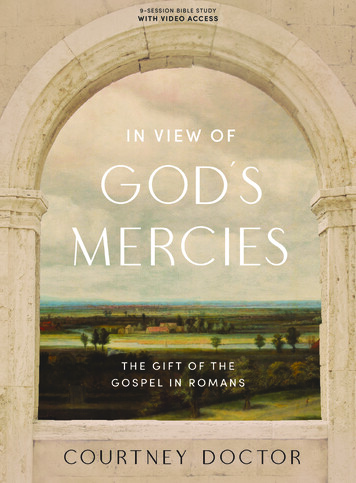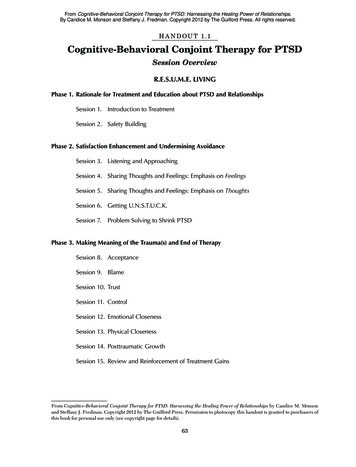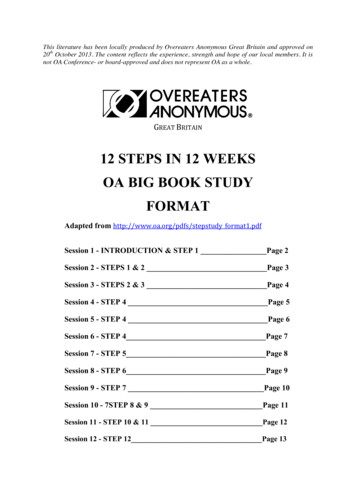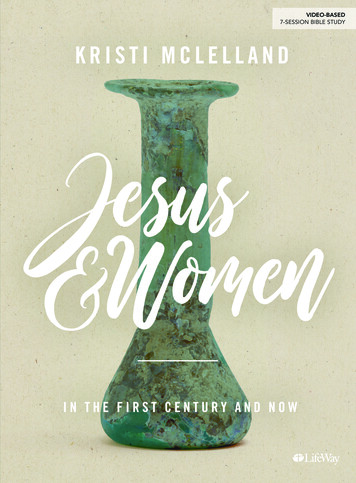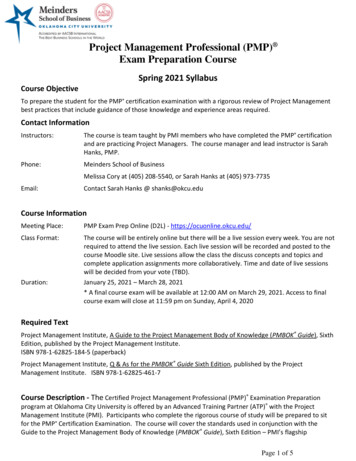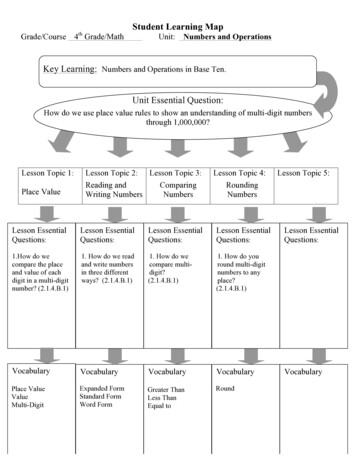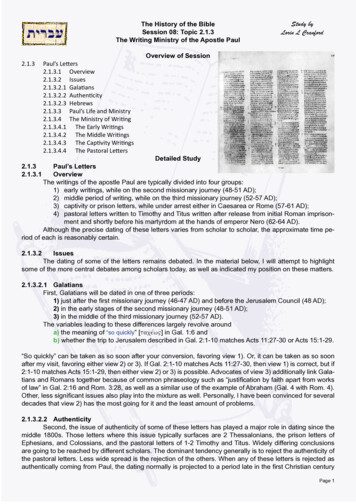
Transcription
The History of the BibleSession 08: Topic 2.1.3The Writing Ministry of the Apostle Paul2.1.3Paul’s Letters2.1.3.1 Overview2.1.3.2 Issues2.1.3.2.1 Galatians2.1.3.2.2 Authenticity2.1.3.2.3 Hebrews2.1.3.3 Paul’s Life and Ministry2.1.3.4 The Ministry of Writing2.1.3.4.1 The Early Writings2.1.3.4.2 The Middle Writings2.1.3.4.3 The Captivity Writings2.1.3.4.4 The Pastoral LettersStudy byLorin L CranfordOverview of SessionDetailed StudyPaul’s LettersOverviewThe writings of the apostle Paul are typically divided into four groups:1) early writings, while on the second missionary journey (48-51 AD);2) middle period of writing, while on the third missionary journey (52-57 AD);3) captivity or prison letters, while under arrest either in Caesarea or Rome (57-61 AD);4) pastoral letters written to Timothy and Titus written after release from initial Roman imprisonment and shortly before his martyrdom at the hands of emperor Nero (62-64 AD).Although the precise dating of these letters varies from scholar to scholar, the approximate time period of each is reasonably certain.2.1.32.1.3.12.1.3.2 IssuesThe dating of some of the letters remains debated. In the material below, I will attempt to highlightsome of the more central debates among scholars today, as well as indicated my position on these matters.2.1.3.2.1 GalatiansFirst, Galatians will be dated in one of three periods:1) just after the first missionary journey (46-47 AD) and before the Jerusalem Council (48 AD);2) in the early stages of the second missionary journey (48-51 AD);3) in the middle of the third missionary journey (52-57 AD).The variables leading to these differences largely revolve arounda) the meaning of “so quickly” [tacevw ] in Gal. 1:6 andb) whether the trip to Jerusalem described in Gal. 2:1-10 matches Acts 11:27-30 or Acts 15:1-29.“So quickly” can be taken as so soon after your conversion, favoring view 1). Or, it can be taken as so soonafter my visit, favoring either view 2) or 3). If Gal. 2:1-10 matches Acts 11:27-30, then view 1) is correct, but if2:1-10 matches Acts 15:1-29, then either view 2) or 3) is possible. Advocates of view 3) additionally link Galatians and Romans together because of common phraseology such as “justification by faith apart from worksof law” in Gal. 2:16 and Rom. 3:28, as well as a similar use of the example of Abraham (Gal. 4 with Rom. 4).Other, less significant issues also play into the mixture as well. Personally, I have been convinced for severaldecades that view 2) has the most going for it and the least amount of problems.2.1.3.2.2 AuthenticitySecond, the issue of authenticity of some of these letters has played a major role in dating since themiddle 1800s. Those letters where this issue typically surfaces are 2 Thessalonians, the prison letters ofEphesians, and Colossians, and the pastoral letters of 1-2 Timothy and Titus. Widely differing conclusionsare going to be reached by different scholars. The dominant tendency generally is to reject the authenticity ofthe pastoral letters. Less wide spread is the rejection of the others. When any of these letters is rejected asauthentically coming from Paul, the dating normally is projected to a period late in the first Christian centuryPage 1
or more typically to the early decades of the second century. The use of material from most of these letters inthe writings of the Apostolic Fathers in the first half of the second century puts a clear terminus point on howlate they can be understood to have arisen. Most of the arguments favoring rejection of Pauline compositionthat I have examined in great detail over the past 40 years carry little persuasiveness and represent flawedscholarly methodology with too much modern cultural bias driving the conclusions. This does not suggestthat the traditional view points, largely derived from the Church Fathers, do not posses problems, for they do,and in some instances rather large problems. But for me the greater problems lay with the proposed alternatives.In light of the historical reality behind these issues, conclusions in many instances must remain tentative, if the Bible student maintains intellectual honesty and is basing viewpoints on concrete data, rather thanon ideological or emotionally driven biases. But intellectual honesty also necessitates drawing honest conclusions and then moving to biblical interpretation based on those conclusions. Dogmatic attitudes therefore areexcluded from serious Bible study. Polemically based castigations of “liberalism” or “fundamentalism” againstdiffering viewpoints adopted through honest inquiry are completely out of place and unchristian. But everyviewpoint is subject to careful scrutiny and intense critique in order to expose its strengths and weaknesses.Only in such endeavor can we come closer to the truth in these matters.2.1.3.2.3 HebrewsThird, the issue of the authorship of Hebrews. Debate over who is responsible for the Letter to theHebrews has existed for a long, long time, as the quote from Leopold Fonck, “The Epistle to the Hebrews”,Catholic Encyclopedia (1910) below notes:a) In the East the writing was unanimously regarded as a letter of St. Paul. Eusebius gives the earliesttestimonies of the Church of Alexandria in reporting the words of a “blessed presbyter” (Pantaenus?), as wellas those of Clement and Origen (Hist. Eccl., VI, xiv, n. 2-4; xxv, n. 11-14). Clement explains the contrast inlanguage and style by saying that the Epistle was written originally in Hebrew and was then translated by Lukeinto Greek. Origen, on the other hand, distinguishes between the thoughts of the letter and the grammaticalform; the former, according to the testimony of “the ancients” (oi archaioi andres), is from St. Paul; the latter isthe work of an unknown writer, Clement of Rome according to some, Luke, or another pupil of the Apostle, according to others. In like manner the letter was regarded as Pauline by the various Churches of the East: Egypt,Palestine, Syria, Cappadocia, Mesopotamia, etc. (cf. the different testimonies in B. F. Westcott, “The Epistle tothe Hebrews”, London, 1906, pp. lxii-lxxii). It was not until after the appearance of Arius that the Pauline originof the Epistle to the Hebrews was disputed by some Orientals and Greeks.(b) In Western Europe the First Epistle of St. Clement to the Corinthians shows acquaintance with the textof the writing (chs. ix, xii, xvii, xxxvi, xlv), apparently also the “Pastor” of Hermas (Vis. II, iii, n.2; Sim. I, i sq.).Hippolytus and Irenaeus also knew the letter but they do not seem to have regarded it as a work of the Apostle(Eusebius, “Hist. Eccl.”, xxvi; Photius, Cod. 121, 232; St. Jerome, “De viris ill.”, lix). Eusebius also mentions theRoman presbyter Caius as an advocate of the opinion that the Epistle to the Hebrews was not the writing of theApostle, and he adds that some other Romans, up to his own day, were also of the same opinion (Hist. Eccl.,VI, xx, n.3). In fact the letter is not found in the Muratorian Canon; St. Cyprian also mentions only seven lettersof St. Paul to the Churches (De exhort. mart., xi), and Tertullian calls Barnabas the author (De pudic., xx). Upto the fourth century the Pauline origin of the letter was regarded as doubtful by other Churches of WesternEurope. As the reason for this Philastrius gives the misuse made of the letter by the Novatians (Haer., 89), andthe doubts of the presbyter Caius seem likewise to have arisen from the attitude assumed towards the letter bythe Montanists (Photius, Cod. 48; F. Kaulen, “Einleitung in die Hl. Schrift Alten und Neuen Testaments”, 5th ed.,Freiburg, 1905, III, 211).After the fourth century these doubts as to the Apostolic origin of the Epistle to the Hebrews gradually becameless marked in Western Europe. While the Council of Carthage of the year 397, in the wording of its decree, stillmade a distinction between Pauli Apostoli epistoloe tredecim (thirteen epistles of Paul the Apostle) and eiusdemad Hebroeos una (one of his to the Hebrews) (H. Denzinger, “Enchiridion”, 10th ed., Freiburg, 1908, n. 92, oldn. 49), the Roman Synod of 382 under Pope Damasus enumerates without distinction epistoloe Pauli numeroquatuordecim (epistles of Paul fourteen in number), including in this number the Epistle to the Hebrews (Denzinger, 10th ed., n. 84). In this form also the conviction of the Church later found permanent expression. CardinalCajetan (1529) and Erasmus were the first to revive the old doubts, while at the same time Luther and the otherReformers denied the Pauline origin of the letter.This uncertainty is reflected in the sequential listing of Hebrews in the canon of the NT. The Paulinesection begins with Romans and ends with Philemon. The order of listing is based simply on the length ofPage 2
each document. Romans is the longest and Philemon is the shortest. The exceptions to this are the documents written to the same group or individual such as 1-2 Corinthians, 1-2 Thessalonians, and 1-2 Timothy.In these cases the length of the first document determines the position of both documents regardless of thelength of the second document.The general letters begins with James and ends with Jude and follows the same guidelines for sequential listing. Hebrews then is dropped down between the Pauline and the General Letter sections placingit near the Pauline section, but not inside it. Were it inside the Pauline section reflecting clear Pauline authorship, it would come after 2 Corinthians sequentially.2.1.3.3 Paul’s Life and MinistryBefore a clear understanding of Paul’s writing ministry can emerge, some background understandingof this life and gospel ministry must be studied. This is particularly important for Paul, since all his letters were‘occasional’ letters. This means that every writing of Paul in the New Testament was prompted by a particularset of historical circumstances at a specific geographical region in the eastern Mediterranean world of themid-first century. His letters were a substitute presence, and were written simply because circumstances atthat moment made it impossible for the apostle to travel to the location needing attention. Thus Paul’s lettersare ‘historically conditioned’ to a very high level.Such has profound impact on the process of understanding the contents of each letter. Where Paulwas when the letter was written becomes important. What was going on around him at the time of writingshaped some of his thinking. Identifying the situation of those to whom the letter was written takes on greatimportance. Frequently Paul will only allude to a problem in addressing it. Knowing as much about the situation as possible helps us understand how Paul proposes to solve it. And why he takes the particular angleof solution. Of course, when the letter was sent to its recipients is important since problems in the churcheswere always shifting and emerging with new twists and angles. Who helped Paul do the writing is increasinglyunderstood in contemporary scholarship as very important to the interpretive process as well.Below is a Timeline of Paul’s writing ministry, that I developed years ago for use in the classroom.Timeline of Paul’s MinistryMissionary ActivityI. Paul’s early ministryA. Conversion and early activities (AD 33-46)B. First missionary journey (AD 46-47),Acts 13:1-14:28C. Jerusalem council (AD 48),Acts 15:1-35, Gal 2:1-10Writing MinistryGalatians, AD 47 (South Galatian Theory)(From Antioch)II. Paul’s middle period of ministryA. The second missionary journey (ca. AD 48-51),Acts 15:36-18:22B. The third missionary journey (ca AD 52-57),Acts 18:23-21:16I. Paul’s Early Writing MinistryGalatians, AD 49* (South Galatian Theory)(From Macedonia)1 Thessalonians AD 50(From Athens)2 Thessalonians AD 51(From Corinth)II. Paul’s Middle Period Writing Ministry1 Corinthians, AD 54-55(From Ephesus)(Possibly the Prison Letters from Ephesus)2 Corinthians, AD 56(From Macedonia)Romans, AD 57(From Corinth)Galatians, AD 57 (North Galatian Theory)(From Corinth)Page 3
Writing MinistryMissionary ActivityIII. Paul’s final period of ministryA. Arrest in Jerusalem (AD 57),Acts 21:17-23:22B. Imprisonment in Caesarea (AD 57-60),Acts 23:23-26:32Prison Letters,Colossians, AD 57-60(From Caesarea)Ephesians(From Caesarea)Philemon(From Caesarea)(Possibly Philippians also)C. The Voyage to Rome (AD 60),Acts 27:1-28:13D.House Arrest in Rome (AD 61-62),Acts 28:14-31; Eph. 3:1, 4:1, 6:18-22;Phil. 1:12-26; 2:19-30; 4:1-3, 10-19; Col 4:7-18;Philm 22-24.E. Release from Imprisonment and Resumption ofMinistry (AD 63-64),1 Tim. 1:3-4; Titus 1:5, 3:12-13.F. Subsequent Arrest and Execution in Rome(AD 64),2 Tim. 1:8, 15-18; 4:7-21.Philippians, AD 61-62(From Rome)(Possibly the above prison letters also)Pastoral Letters,1 Timothy, AD 63-64(From Macedonia)Titus, AD 63-64(From Nicopolis)2 Timothy, AD 64(From Rome)Notes:This chronological schema depends upon a combination of traditional understanding and modern scholarly insights.It represents but one projection of possible temporal connections between Paul’s work as a missionary and his ministryin letter writing.What is not included here is the much more complex relationship with the Christian community at Corinth. For areconstruction of that, see my “Paul’s Relation to the Church at Corinth” at http://cranfordville.com/paul-cor.htm.Also complex is the internal connection of the four Prison Letters. Clearly Ephesians, Colossians, and Philemon havea close connection. But the connection of Philippians to these three letters is less clear. I see the first three as arisingfrom Paul’s lengthy imprisonment at Caesarea after his arrest in Jerusalem, while Philippians comes later during hishouse arrest as he awaits his first trial before the Roman emperor Nero in the early 60s. The possibility of an Ephesianorigin for either three or all four of these letters certainly exists, but the evidence for it is scanty and thus such an earlydate for the origin of these letters during the third missionary journey is very subjective. For more details, see my “Relationships among the Prison Letters” at http://cranfordville.com/paul-pris.htm.Lastly but far from least is the issue of the Pastoral Letters. Since the F.C. Baur Tübingen School of the 1800s in Germany, much of modern scholarship has been convinced that these letters, 1 & 2 Timothy and Titus, are pseudo-paulineletters, and should be dated anywhere from the late first century to well into the second century AD. As I have studiedthe issue over the past forty years while living both in the US and in Germany, I have become less and less convincedby the arguments put forth in defense of this position. At the same time, increasingly convincing arguments have beenset forth both in critique of the Baur position, as well as in defense of the Pauline connection to these letters. Thus Itend toward the traditional view that Paul did dictate these letters to a writing secretary toward the end of his life andthat they were authorized by the apostle himself before his death, contra the view of P.N. Harrison who sees paulinefragments in a deutero-pauline view. But the evidence is clearly not a black/white matter. In the traditional view, onemust assume some significant developments in the apostle’s thinking about some issues of the Christian belief system.Yet, in his 60s, I would expect Paul’s thinking to be somewhat different than it was in his early 30s, when he first beganministry as a apostle. I certainly hope my thinking has changed and developed over the past forty plus years of Christian ministry. When I preached my first sermon in March of 1958, I understood very little about Christianity. HopefullyI understand much more now, in May of 2005.Lorin L. CranfordPage 4
2.1.3.4 The Ministry of WritingWriting a document of any kind in the first century world was quite an undertaking. Writing materialswere primitive and the process of writing was painstakingly tedious and long. Different kinds of writings haddiffering patterns of composition that were to be followed, just as is true in our contemporary world. But thesepatterns were not the same as is true in today’s world. All of Paul’s writings in the New Testament are in theform of a letter. But letter writing in the ancient world was very different than in our day.Letter Structure. Paul’s letters follow the ancient pattern in their core elements,although the apostle exhibits substantial creativity in expanding and modifying these coreelements. The diagram to the right illustratesthe component elements in a typical ancientletter. The example is taken from Paul’s letterto the Philippians.Four core segments were commonlyfound in the typically one to two page long letters in the first Christian century.The Praescriptio was the introductorysegment written in formulae, rather than sentence, structure. In the Greek pattern camefirst the identification of the sender or sendersof the letter (the Superscriptio). Next were therecipients of the letter identified (the Adscriptio). Thirdly, came the bridging word of greetings from the sender to the recipients (theSalutatio). The usual greeting was but a singleword: caivrein. But Paul usually extends thisto ‘grace and peace.’ (cavri uJmi n kai; eijrh vnh.). Most ancient letters, including both formal and intimate types, at that time containedlittle amplification of each of these three elements. Paul’s letters, on the other hand, usually contain extensiveexpansion elements of these core segments.The Proem section served also as a bridging device and sometimes merely extended the Salutatiosection. The distinctive aspect of the Proem was its prayer structure. The Proem typically invoked the blessing of the deity / deities worshipped by the sender and / or recipient. In Paul’s letters the Proem always beginswith a prayer of thanksgiving to God for the letter recipients. Often, the thanksgiving merges into a petitionaryprayer in behalf of the readers for God to bless them in certain ways. Sometimes the Proem in Paul’s lettersare short, but sometimes they are quite long. Only the letter to Titus omits the Proem.Paul does something in these first two segments that was occasionally done by ancient letter writers.In the expansion of the core elements in either the Praescriptio and the Proem, or in just one of these, Paulwill signal the major themes to be addressed in the Body proper of the letter. Thus by the end of the Proemthe reader has some idea of what Paul is going to talk about in the Body section of the letter.The Body of the letter does not follow any prescribed structure. The arrangement of the contents depended on the creativity of the writer and on the general purpose for the writing of the letter. Quite a numberof guidelines in these matters existed in the ancient world and were generally adhered to by letter writers,especially in the writing of formal letters over against personal letters. Paul exhibits considerable creativity inthis section of his letters, although definable literary forms that he used can be traced out.The Conclusio is the final section of ancient letters. This section provided the writer the opportunity to‘wrap up’ his thoughts, and from the hundreds of surviving ancient letters available to us today, we can detectseveral distinct sub-units of material were possible to insert at this point. Paul’s letters will usually have somecombination of four sub-units: Greetings, Sender Verification, Doxologies, and Benediction. Occasionally additional material is also inserted.Letter Writing Process. The actual writing of ancient letters, outside of very brief personal letters,was done by a writing secretary employed by the sender of the letter for this laborious task. These individualswere known as scribes, in Greek grammateuv and in Latin amanuensis. They had training in writing, takingdictation etc. and were more polished in writing out documents. Paul alludes to this practice in 2 Thess. 3:17by indicating that he had only written the Conclusio part of the letter according to his usual custom with hisPage 5
letters: “I, Paul, write this greeting with my own hand. This is the mark in every letter of mine; it is the way I write.“ Unfortunately we don’t know the names of the individuals who did the actual writing of Paul’s letters, outside ofTertius who identifies himself as the writer of the letter to the Romans in Rom. 16:22: “I Tertius, the writer of thisletter, greet you in the Lord.“ Elsewhere in the New Testament, Silas identifies himself by his Latin name, Silvanus, as the writer of 1 Peter in 1 Pet. 5: “Through Silvanus, whom I consider a faithful brother,I have written this short letter to encourage you and to testify that this isthe true grace of God.“ The typical process of that time most likelywas followed by Paul with the composition of his letters. This normally involved the sender of the letter sketching out verbally whathe wanted to say, and the writing secretary would then write out adraft form on a board with warm wax as the writing surface. Oncethe letter had been proofed, revised, and brought to finalized form,the letter would be written on a more permanent surface, usuallypapyrus. Then the sender would put his ‘stamp of verification’ onthe letter -- usually the writing of the Conclusio in his own handwriting that was familiar to the letter recipients (cf. 2 Thess. 3:17 and Gal. 6:11-181 for examples).In this way the apostle Paul was responsible for eleven of the twenty-seven documents in our NewTestament.The question naturally arises over whether this is all that the apostle Paul wrote. And the answer tothat question can be answered from data inside the New Testament as “No, Paul wrote more than what wehave in the New Testament.” From the writings of Paul to the Corinthian church we know with certainty thathe wrote at least four letters to the church at Corinth, but we only have two of them in our New Testament.And depending on how Col. 4:16 is understood,2 there quite possibly was a letter to the church at Laodiceathat Paul also wrote. How many others may have existed at one time and have been lost we do not know.But of those in the New Testament the following summary is important, that is based upon the abovelisted timeline.Gal. 6:11 (NRSV): “See what large letters I make when I am writing in my own hand!.””And when this letter [i.e., Colossians] has been read among you, have it read also in the church of theLaodiceans; and see that you read also the letter from Laodicea.” (Col. 4:16, NRSV)12Page 6
2.1.3.4.1 The Early WritingsGalatians. After Paul and Silas had passed through the Galatian province on the second missionaryjourney in the late 40s of the first century, they moved on to Macedonia to establish churches at Philippi,Thessalonica, etc. While there word came that the Galatian churches were coming under the growing influence of Judaizing teaching that claimed that one could not become a Christian without first converting to Judaism, since “salvation was of the Jews only.” The letter is written as a stinging rebuke of these false teachersand as a passionate appeal to the believers in Galatia to remain steadfastly committed to the apostolic gospelof ‘justification by faith apart from works of Law.’1 Thessalonians. After Paul had left Thessalonica in Macedonia around 50 AD on this same missionary journey, he landed in Athens to preach the gospel to this city. Timothy and Silas soon joined him therewith a report on the situation of the church in Thessalonica. Paul’s first letter to the church was written fromAthens and carried to Thessalonica by Timothy (cf. 1 Thess. 3:1) to encourage the church and to correctsome understandings about the gospel, in particular about the second coming of Christ.2 Thessalonians. A few months later after Paul had moved on to Corinth from Athens Timothy rejoined Paul at Corinth with another update on the situation at Thessalonica. More serious problems, especially about Christ’s return, were surfacing at Thessalonica and this letter was written to address these issuesalong with encouraging the church to remain faithful to Christ.From Corinth in 51 AD Paul heads back to Jerusalem and then to Antioch to report to this congregation what God has done in raising up new churches.2.1.3.4.2 The Middle Writings1 Corinthians. On the third missionary journey (AD 52-57), Paul and Silas along with others travelingwith them move due west from Galatia to Ephesus on the western coast of the Roman province of Asia. HerePaul will spend almost three years in a lengthy mission in and around Ephesus. At some point evidently earlyon at Ephesus, Paul penned a letter to the Corinthians that he mentions in 1 Cor. 5:9. This letter is now lost,in spite of some scholarly opinion contending that part of it is contained in 2 Cor. 6:14-7:1. The circumstancesprompting the writing of this letter are not clear, but at least in part had to do with immoral behavior by someof the Corinthians while professing to be Christian.At some point during this lengthy Ephesian ministry Paul received two reports about more seriousproblems in the church continuing to develop in Corinth. Members of the household of Chloe were in Ephesus on business and brought a report of several significant problems which Paul addressed in chapters onethrough six of 1 Corinthians. Also during the same general period of time a group of Corinthian believerstraveled to Ephesus to raise specific questions to Paul on several topics and he addresses those issues inchapters seven through sixteen of 1 Corinthians.Sometime afterwards Paul evidently decided to make a quick visit to Corinth in order to correct someof the problems still unresolved in the church (cf. 2 Cor. 2:1; 12:14; 13:1,2 for sources). The trip proved to bevery painful for the apostle and didn’t achieve the success he had hoped for.2 Corinthians. During the final months at Ephesus toward the middle 50s, Paul encountered viciousopposition to the preaching of the gospel in Ephesus (cf. Acts 19:1-20:1). He had sent Titus ahead to Corinthto see whether Titus could help solve the problems at Corinth and to resolve some of the animosity againstPaul that had developed there. Paul left Ephesus and headed northwest into Macedonia where he and Silasspent some time. In part he was waiting to hear from Titus who was to meet him in Macedonia with a reporton the situation at Corinth. This would determine whether he went on to Corinth or headed on to Jerusalemfrom Macedonia. A major activity of Paul during the third missionary journey had been the collection of a sizeable ‘relief offering’ from the Gentile churches of Asia, Macedonia and Achaia to take to the believers in Judeawho were suffering from both persecution and a severe drought in that part of the world. Titus showed up withbasically good news about Corinth. In response Paul wrote 2 Corinthians to encourage the Corinthians, andto vigorously defend his right as an apostle. Titus carried this letter back to Corinth ahead of Paul and thedelegation of other believers who were traveling with Paul at this point representing their churches with therelief offering.Romans. Upon arriving at Corinth, Paul spent three months in ministry there (cf. Acts 20:3) beforeheading to Jerusalem to celebrate the Jewish festival of Pentecost in the temple (cf. Acts 20:16). During thattime in Corinth, he began anticipating future ministry in Rome (cf. Acts 19:21). As a part of that growing conviction he dictated the letter to the Romans to his writing secretary, Tertitus (cf. Rom. 16:22). This letter, themost carefully crafted of any of Paul’s writings, was to serve as an introduction of the apostle to a congregation whom he did not know from personal experience, although he knew many of its leaders from encounterselsewhere in the empire. In this letter Paul comes the closest to setting forth a “biblical theology” as can bePage 7
found anywhere in the New Testament. In the lengthy body of the letter he places his gospel message onthe table in carefully laid out fashion. His dream was that Rome could serve as a launch pad for extendedministry in the western Mediterranean just as Antioch had been for the northeastern Mediterranean world (cf.Rom. 15:14-33). A growing sense of imminent danger developed in Paul as he headed for Jerusalem, but heremained confident of God’s watch care over him and of the necessity of traveling to Jerusalem.2.1.3.4.3 The Captivity WritingsOnce Paul arrived in Jerusalem to celebrate Pentecost in late spring of AD 57, things did not go theway he had planned. Instead of being able to worship God in the temple and then move on to Antioch in thenorth, he found himself embroiled in a substantial controversy with the Jewish religious leadership who weredetermined to get rid of him at all costs. The threat on his life became so severe that the Roman military commander whisked him away at midnight from Jerusalem to the central military garrison at Caesarea Philippion the Mediterranean coast. There he would remain for over two years occasionally having to defend himselfagainst trumped up charges brought against him by the Jewish authorities (cf. Acts 23:16-26:32). In desperation he drew upon one of the privileges of his Roman citizenship and appealed to the emperor to hear hiscase. The Roman governor Festus had no choice but to grant his demand.Ephesians. During this lengthy two year imprisonment Paul kept busy in part with the writing of aseries of letters to churches in western Asia. Ephesians was composed not only for the church at Ephesus,but as a ‘cover letter’ to serve as an introduction to the other letters of Colossians and Philemon (and maybethe one to the Laodiceans also). Thus Ephesians treats eloquent themes of the exalted nature of the churchas the Body of Christ with all that implies for righteous living.Colossians. Both Colossians and Philemon are sent to the inland town of Colossae some hundredor so kilome
Detailed Study 2.1.3 Paul’s Letters 2.1.3.1 Overview The writings of the apostle Paul are typically divided into four groups: 1) early writings, while on the second missionary journey (48-51 AD); . excluded from serious Bible study. Polemically based
